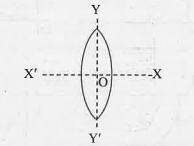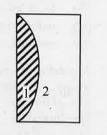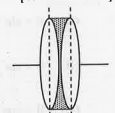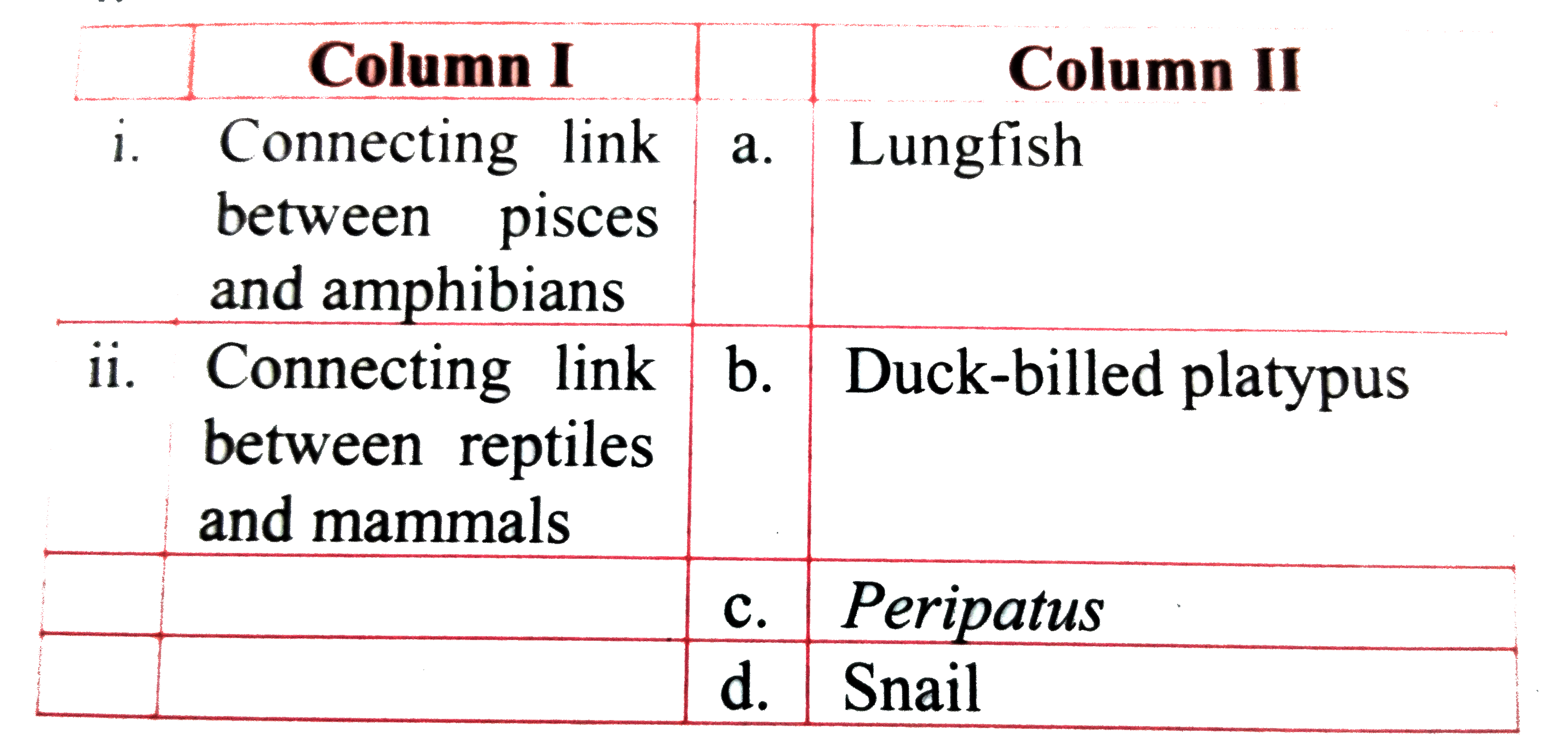Complete Solutions to COMPETITIVE THINKING of chapter RAY OPTICS of Class 11 book with complete answers and questions
| Class 11 | PHYSICS |
| Chapter | RAY OPTICS |
| TARGET PUBLICATION | COMPETITIVE THINKING |
| Number Of Questions | 68 |
| Academic Year | 2023-24 |
An object is placed at a distance of `40 cm` from a concave mirrorr of focal length `15 cm`. If the object is displaced through a distance of `20 cm` towards the mirrorr, the displacement of the image will be
View SolutionA point object is placed at a distance of 30 cm from a convex mirror of focal length 30 cm. The image will form at
View SolutionWhich of the following statements is incorrect?
View SolutionA concave mirror of focal length `f` (in air) is immersed in water `(mu=4//3)`. The focal length of the mirror in water will be
View SolutionA linear object of heigth 10 cm is kept in front of concave mirror of radius of curvature 15 cm, at distance of 10 cm. The image formed is
View SolutionA person wants a real image of his own, 3 times enlarged. Where should he stand in front of a concave mirror of radius of curvature of 30cm.
View SolutionConsider a light source placed at a distance of 1.5 m along the aixs facing facing the convex side of a spherical mirror of radius of curvature 1m. The position (s), nature and magnification (m) of the image are
View SolutionThe power of plane mirror is _______.
View SolutionTwo convex lenses of focal lengths `f_(1)andf_(2)` form images with magnification `m_(1)andm_(2)`, when used individually for an object kept at the same distance from the lenses. Then `f_(1)//f_(2)` is
View SolutionAccording to Cartesian sign convention, in ray optics
View SolutionA poinit object `O` is placed in front of a glass rod having spherical end of radius of curvature `30cm`. The image would be formed at

View SolutionA candle placed 25 cm from a lens, forms an image on a screen placed 75 cm on the other end of the lens. The focal length and type of the lens should be
View SolutionFocal length of a convex lens is 20 cm and its R.I. is 1.5. It produces an erect, enlarged image if the distance from the object of the lens is
View SolutionA convex lens (with material of refractive index of 3/2) has two surfaces of equal radii of curvature R. The magnitude of its focal length is
View SolutionConvex lens made up of glass `(mu_(g)=1.5)` and radius of curvature R is dipped into water. Its focal length will be (Refractive index of water =4/3)
View SolutionA convex glass lens `(mu_(g) = 1.5)` has a focal length of 8 cm when placed in air. What is the focal length of the lens when it is immersed in water ?
`(mu_(omega) = (4)/(3))`
View SolutionA double convex thin lens made of glass (refractive index `mu = 1.5`) has both radii of curvature of magnitude 20 cm . Incident light rays parallel to the axis of the lens will converge at a distance L such that
View SolutionIn the figure an air less of raddi of curvature 10 cm `(R_1 = R_2 = 10 cm)` is cut in a cylinder of glass (n = 1.5). The focal length and the nature of the lens is

View SolutionA plano-convex lens is made of material having refractive index 1.5. The radius of curvature of curved surface is 60 cm. The focal length of the lens is ______ cm.
View SolutionTwo identical thin planoconvex glass lenses (refractive index `1.5)` each having radius of curvature of `20cm` are placed with their convex surfaces in contact at the centre. The intervening space is filled with oil of refractive index `1.7`. The focal length of the combination is
View SolutionA thin convex lens made from crown glass `(mu=(3)/(2))` has focal length f. When it is measured in two different liquids having refractive indices `(4)/(3)` and `(5)/(3)`, it has the focal lengths `f_1` and `f_2` respectively . The correct relation between the focal lengths is ,
View SolutionIn an optics experiment, with the position of the object fixed, a student varies the position of a convex lens and for each position, the screen is adjusted to get a clear image of the object. A graph between the object distance u and the image distance v, from the lens, is plitted using the same scale for the two axes. A straight line passing through the origin and making an angle of `45^circ` with x-axis meets the experimental curve at P. The coordinates of P will be.
View SolutionThe equiconvex lens has focal length f. If is cut perpendicular to the principal axis passing through optical centre, then focal length of each half is
View SolutionAn equiconvex lens is cut into two halves along (i) XOX' and (ii) YOY' as shown in the figure. Let f, f ', f " be the focal lengths of the complete lens, of each half in case (i), and of each half in case (ii), respectively.

Choose the correct statement form the following.
View SolutionA converging beam of rays in incident on a diverging lens. Having passed through the lens the rays intersect at a point `15 cm` from the lens. If the lens is removed, the point where the rays meet, move `5 cm` closer to the mounting that holds the lens. Find the focal length of the lens.
View SolutionGraph of position of image vs position of point object from a convex lens is shown. Then, focal length of the lens is

View SolutionCalculate the focal length of a reading glass of a person, if the distance of distinct vision is 75cm.
View SolutionAn object is located 4 m from the first of two thin converging lenses of focal lengths 2 m and T m respectively. The lenses are separated by 3 m. The final image formed by the second lens is located from the source at a distance of

View SolutionA beam of parallel rays is brought to focus by a planoconvex lens. A thin Concave lens of the same focal length is joined to the first lens. The effect of this is
View SolutionA plano-convex lens fits exactly into a plano-concave lens. Their plane surfaces are parallel to each other. If the lenses are made of different material of refractive indices `mu_(1)` and `mu_(2)` and R is the radius of curvature of the curved surface of the lenses, then focal length of the combination is
View SolutionA plano-convex lens fits exactly into plano-concave lens as shown in the figure. Their plane surfaces are parallel to each other. If the lenses are made of different materials of refractive indices 1.6 and 1.5 respectively, if R is the radius of curvature of curved surface of lenses, then the focal length of the combination

View SolutionTwo lenses of power `+12` and `-2` dioptres are placed in contact. The combined focal length of the combination will be
View SolutionA comvex lens and a concave lens are placed in contact. The ratio of magnitude of the power of the convex lens to that of the concave lens is 4:3. If the focal length of the convex lens is 12 cm, then the focal length of the combination will be
View SolutionTwo identical glass `(mu_(g)=3//2)` equiconvex lenses of focal length f are kept in contact. The space between the two lenses is filled with water `(mu_(w)=4//3)` . The focal length of the combination is
View SolutionTwo identical equiconvex lenses, each of focal length 'f' are placed side by side in contact with each other with a layer of water in between them as shown in the figure. If refractive index of the material of the lenses is greater than that of water, how the combined focal length 'F' is related of 'f'?

View SolutionA bi-convex lens is formed with two thin plano convex lenses as shown in the figure. Refractive index n of the first lens is 1.5 and that of the second lens is 1.2. Both the curved surfaces are of the same radius of curvature R = 14 cm. For this bi-convex lens, for an object distance of 40 cm, the image distance will be

View SolutionTwo convex lenses of focal length `f_1` and `f_2` are mounted coaxially separated by a distance. If the power of the combination is zero, the distance between the lenses is
View SolutionA diverging lens with magnitude of focal length `25 cm` is placed at a distance of `15 cm` from a converging lens of magnitude of focal length `20 cm`. A beam of parallel light falls on the diverging lens. The final image formed is.
View SolutionA convex lens of focal length 12.5 cm is used as a simple microscope. When the image is formed at infinite, magnification is _______ (Near point for the normal vision is 25 cm).
View SolutionLeast distance of distinct vision is 25 cm . Magnifying power of simple microscope of focal length 5 cm is
View SolutionIn compound microscope, the focal length and aperture of the objective used is respectively
View SolutionIn a compound microscope, the intermediate image is
View SolutionA compound micrscope consists of an objective of focal length 1.0 cm and an eyepiece of focal length 5.0 cm separated by 12.2 c.a. At wht distance from the objective should a object be placed to focus it prope4y so that the final image is formed at the least distance of clear vision (25cm)? b. calculate the angular magnificationn in this case.
View SolutionAn obsever looks at a distant tree of height 10m with a telescope of magnifying power of 20. to the observer the tree appears:
View SolutionAn astronomical telescope has an angular magnification of magnitude 5 for distant object. The separation between the objective and the eyepiece is 36 cm and the final image is formed at infinity. The focal length `f_(0)` of the objective and the focal length `f_(0)` of the eyepiece are
View SolutionOn which of the following does the magnifying power of a telescope depends
View SolutionThe number of lenses in a terrestrial telescope is
View SolutionTo avoid spherical aberration, quality reflecting telescopes use mirrors whose cross-sectional shapes are
View SolutionAn astronomical telesope has objective and eyepiece of focal lengths `40cm` and `4 cm` respectively. To view an object `200cm` away from the objective, the lenses must be separated by a distance `:`
View SolutionA telescope using an eye piece of focal length 3 cm has a magnification 10 in normal adjustment. If the telescope is now used to view an object placed at a distance of 180 cm from the objective, the new length of the telescope is (assume final image is at infinity).
View SolutionIn an astronomical telescope in normal adjustment a straight black line of length `L` is drawn on inside part of objective lens. The eye piece forms a real image of this line. The length of this image is `I`. The magnification of the telescope is
View SolutionThe ratio of the diameter of the sun to the distance between the earth and the sun is approximately 0.009. The approximate diameter of the image of the sun formed by a concave spherical mirror of radius of curvature 0.4 m is
View SolutionA point object is held above a thin equiconvex lens at its focus. The focal length is 0.1 m and the lens rests on a horizontal thin plane mirror. The final image will be formed at
View SolutionA concave lens of glass, refractive index 1.5 has both surfaces of same radius of curvature R. On immersion in a medium of refractive index 1.75, it will behave as a
View SolutionGiven a point source of light, which of the following can produce a parallel beam of light
View Solutionchoose the correct option

View SolutionAn infinitely long bar lies alont the adis of cancave mirror of focal length f. the nerar end of bar is a distance `v gt f` from the mirror. Its images will have a length
View SolutionDiameter of a plano-convex lens is 6cm and thickness at the centre is 3mm. If speed of light in material of lens is `2xx10^(8)(m)/(s)`, The focal length of the lens is
View SolutionThe image of an object, forme by a plano-convex lens at a distance of 8m behind the lens, is real and is one-third the size of the object. The wavelength of light inside the lens is `(2)/(3)` times the wavelength is free space. The radius of the curved surface of the lens is
View SolutionBy placing a comvex lens of focal length equal to 15.0 cm between an object and a screen separated by a distance of 75.0 cm, the sizes of the images obtained are 6.0 cm and `(2)/(3)cm`. The size of the object must be
View SolutionFor a normal eye, the cornea of eye provides a converging power of `40 D` and the least converging power of the eye lens behind the cornea is `20 D`. Using this information, the distance between the retina and the cornea eye lens can be estimated to be
View SolutionA person can see objects clearly only when they lie between `50cm` and `400 cm` from his eyes. In order to increase the maximum distance of distinct vision to infinity, the type and power of the correcting lens, the person has to use, will be
View SolutionThe focal length of a plano-convex lens is `f` and its refractive index is 1.5 it is kept over a plane galss plate with its curved surface touching the glass plate. The gap between the lens and the glass plate is filled by a liquid. As a result the effective focal length of the combination becomes `2f`. Then the refractive index of the liquid is
View SolutionA convex lens of glass `(mu_(g)=1.45)` has focal length `f_(g)` is air. The lens is immersed in a liquid of refractive index `(mu_(g))` 1.3. The ratio of the `f_(liquid)//f_(g)` is
View SolutionConvex lens is made of glass of refractive index `1.5` If the radius of curvature of each of the two surfaces is `20 cm` find the ratio of the powers of the lens, when placed in air to its power, when immersed in a liquid of refractive index `1.25`.
View SolutionRelative difference of focal lengths of objective and eye lens in the microscope and telescope is given as
View SolutionThree thin lenses are combined by placing them in contact with each other to get more magnification in an optical instrement. Each lens has a focal length of 3 cm. If the least distance of distinct vision is taken as 25 cm, the total magnification of the lens combination in normal adjustment is
View SolutionIf the focal length of the objective lens is increased then
View Solution
COMPETITIVE THINKING questions and complete solutions for chapter RAY OPTICS of TARGET PHYSICS (MARATHI ENGLISH) of Class 11